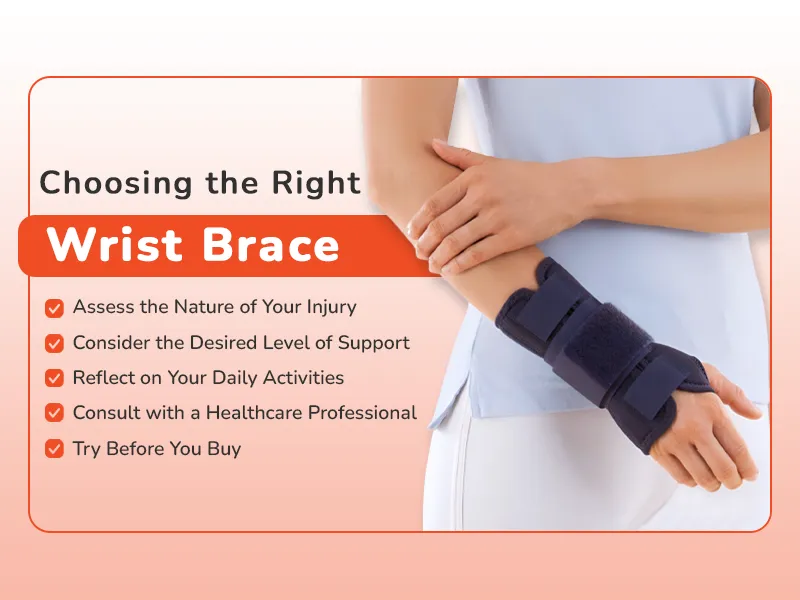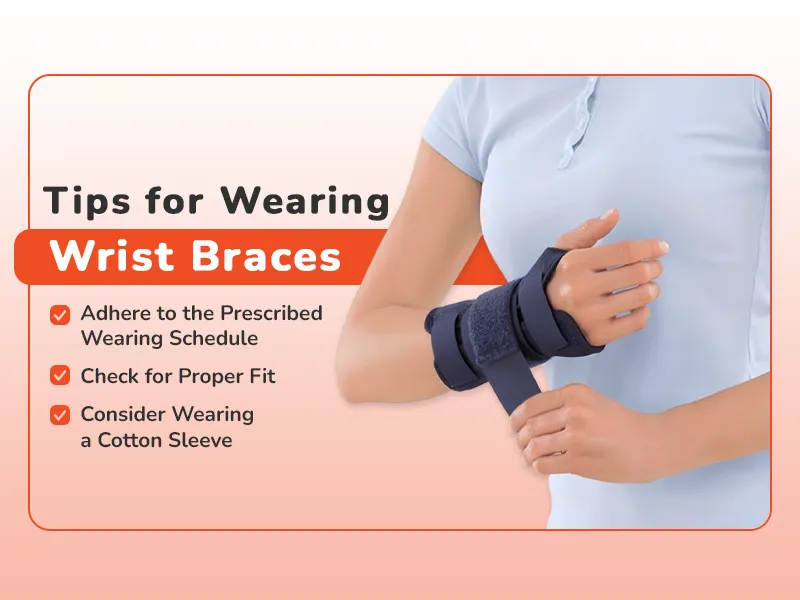Wrist injuries are surprisingly common, impacting athletes and those engaged in daily routines, from typing at a desk to performing manual labour. The wrist, a complex and indispensable joint, plays a pivotal role in almost all hand movements, making its health paramount for professional and personal activities. Recognizing the critical nature of this joint, wrist braces have become invaluable in preventing injuries and aiding in rehabilitation. This blog explores the significance of wrist braces, delving into the various types available and their key benefits and offering practical advice on selecting and utilizing these supports effectively. Through this guide, readers will gain insights into safeguarding their wrist health, ensuring they are equipped with the knowledge to choose the right brace for injury prevention and efficient recovery.
Understanding Wrist Braces
Wrist braces are crucial support systems engineered specifically to bolster the wrist joint. These devices play a vital role in preventive care and rehabilitation by offering stability and limiting movements that might exacerbate an injury or hinder healing. The versatility in their design allows for a wide spectrum of needs to be met, accommodating everything from minor sprains that require gentle support to more severe conditions needing robust stabilization. In various designs, wrist braces can be as simple as lightweight wraps that provide basic support and compression or more elaborate structures with rigid components designed for significant immobilization. This range ensures that individuals find a wrist brace that addresses their specific condition and fits into their daily lives, allowing for healing and protection without compromising functionality.
The Role of Wrist Braces in Injury Prevention
Wrist braces are instrumental in mitigating the risk of injuries, especially when the wrist is subjected to repetitive stress or sudden impacts. By providing essential stabilization, these devices ensure that the wrist maintains an optimal alignment during activities that might pose a high risk for strains, sprains, or more serious injuries. This preventive measure is invaluable not just for athletes, who often push their wrists to the limits in sports, but also for individuals engaged in hobbies or occupations that involve consistent wrist motion. Whether it’s typing, playing musical instruments, or performing manual labour, wearing a wrist brace can significantly reduce the likelihood of injury, helping to maintain wrist health and continuous activity without interruption. This protective strategy underscores the importance of wrist braces in safeguarding against potential damage, highlighting their role as a critical tool in injury prevention.
How Wrist Braces Aid in Recovery
Wrist braces are a cornerstone in the recovery process from wrist injuries, offering a multifaceted approach to healing. They provide crucial benefits that hasten the recovery timeline and ensure a more effective and safer healing journey.
- Immobilizing the Wrist: One of the primary functions of a wrist brace during recovery is to immobilize the wrist. This immobilization is key to maintaining the wrist’s correct alignment, allowing tissues to heal properly without interfering with movements that could disrupt the process. By securing the wrist in a stable position, braces facilitate an environment conducive to optimal healing, ensuring that the recovery foundation is as robust as possible.
- Reducing Pain and Swelling: Wrist braces apply gentle compression to the injured area, significantly reducing pain and swelling. This compression aids in controlling inflammation, a common response to injury, and helps minimise discomfort. The reduction of swelling not only alleviates pain but can also improve the overall functionality of the hand during the recovery phase, making daily tasks more manageable.
- Preventing Re-Injury: By restricting movement, wrist braces safeguard against re-injury. During recovery, the wrist is vulnerable; even minor stresses can significantly restore healing progress. A wrist brace protects the wrist from movements and stresses that could lead to further damage. This protection is especially crucial in the early stages of recovery when the wrist is most susceptible to re-injury.
Types of Wrist Braces
Wrist braces are designed with various features to cater to different types of wrist conditions and injuries, ensuring that individuals can select a brace that best meets their needs. Here’s a closer look at the common types of wrist braces available:
- Compression Wraps: These are the simplest form of wrist supports, primarily used for minor wrist sprains and strains. Compression wraps are made from elastic materials that provide a snug fit around the wrist, offering gentle support and compression. This slight pressure helps reduce swelling and provides support that can be particularly comforting during daily activities. Their flexibility and ease of use make compression wraps popular for those seeking relief from mild discomfort without needing significant immobilization.
- Rigid Braces: For those recovering from more serious conditions, such as severe sprains, fractures, or post-surgical recovery, rigid braces offer the highest level of support and stabilization. Typically constructed with hard materials like plastic or metal, these braces are designed to immobilize the wrist fully, preventing any movements that could hinder the healing process. Rigid braces often come with features like splints or stays, which are crucial for maintaining the wrist in a fixed position, ensuring proper alignment and healing.
- Adjustable Braces: Adjustable braces balance flexibility and support, making them suitable for various injuries and recovery stages. Equipped with straps, Velcro, or laces, these braces allow for a customizable fit, enabling the wearer to adjust the compression level and support as needed. This adjustability is particularly beneficial as it can accommodate changes in swelling throughout the recovery process and can be tailored to provide more support during activities that might stress the injured wrist. Adjustable braces offer a versatile solution, catering to the need for mobility and protection during the healing journey.
Choosing the Right Wrist Brace
Choosing the correct wrist brace is pivotal for effective recovery and injury prevention, necessitating carefully evaluating various factors to ensure the brace meets your specific needs. Here’s a guide to selecting the right wrist brace:

- Assess the Nature of Your Injury: The type of wrist injury you have is the primary determinant of the kind of brace you’ll need. Different injuries require different levels of support. For instance, a mild sprain may only require a wrap’s gentle compression, while a fracture or post-surgical condition could necessitate a rigid brace for maximum immobilization. Understanding the extent and nature of your injury is the first step in narrowing down your options.
- Consider the Desired Level of Support: Wrist braces offer a range of support, from flexible to rigid. Consider how much movement you should reasonably restrict to aid your recovery. For ongoing support or mild injuries, an adjustable brace might provide the balance between mobility and protection you need. A rigid brace might be necessary for severe injuries to ensure proper healing.
- Reflect on Your Daily Activities: The activities you engage in while wearing your wrist brace also influence your choice. If you lead an active lifestyle or participate in sports, you might require a brace that offers both support and flexibility, allowing for some movement. Conversely, if your goal is to restrict wrist motion as much as possible to speed up healing, a more restrictive brace could be more suitable.
- Consult with a Healthcare Professional: Consulting is the most crucial step in selecting a wrist brace. A doctor, physical therapist, or orthopaedic specialist can provide a recommendation based on a thorough assessment of your condition. They can advise on the specific type of brace that would best suit your injury and recovery goals, considering your injury’s severity and daily needs.
- Try Before You Buy: If possible, try on different braces to see which one feels most comfortable and provides the appropriate level of support. A good fit should feel supportive but not overly restrictive, allowing for some degree of movement unless complete immobilization is necessary for healing.
Benefits of Wearing Wrist Braces
Wearing wrist braces brings many advantages to those dealing with wrist issues, whether for preventive measures or as part of a recovery plan. These benefits include:
- Enhanced Recovery Speed: Wrist braces facilitate optimal healing by maintaining the wrist in the correct alignment. This proper alignment is crucial for natural healing, allowing quicker injury recovery by ensuring that the wrist bones and tissues mend in the right position.
- Reduced Risk of Further Injury: Wrist braces effectively limit movements that could exacerbate existing injuries or lead to new ones, especially during activities that stress the wrist. This protective measure is essential for preventing setbacks during recovery and for individuals who engage in repetitive wrist movements in daily activities or sports.
- Decreased Pain and Swelling: The compression provided by wrist braces helps manage swelling by applying gentle pressure to the wrist area, which can aid in reducing inflammation. Additionally, the support offered by the brace can alleviate pain by stabilizing the wrist and minimizing stress on the injured area.
Wrist Brace Care and Maintenance
To ensure that your wrist brace continues to provide these benefits effectively, proper care and maintenance are essential:
- Regular Cleaning: Follow the cleaning instructions provided by the manufacturer closely. Most braces can be hand-washed with mild soap and lukewarm water. Regular cleaning is essential to prevent the buildup of sweat and bacteria, which can lead to skin irritation and compromise the material integrity of the brace.
- Inspect for Wear and Tear: Regularly check your wrist brace for any signs of wear and tear, such as stretching, fraying, or damage to the material and fastenings. A brace that is worn out may not provide adequate support and could potentially cause discomfort or further injury.
- Make Necessary Adjustments or Replacements: If you notice any issues during your inspections, adjust the brace as needed to ensure it continues to fit correctly and provide the right level of support. If adjustments cannot fix the problem, it may be time to replace the brace entirely to maintain the support needed for your wrist’s recovery or protection.
Read More: Wrist Braces for Carpal Tunnel Relief and Wrist Support
Tips for Wearing Wrist Braces
Wearing a wrist brace correctly is essential to ensure that it effectively aids injury prevention and recovery. Here are some practical tips to maximize the benefits of your wrist brace:

- Adhere to the Prescribed Wearing Schedule: Your healthcare provider will recommend a wearing schedule based on your specific condition. Following this schedule is crucial to ensure the brace aids recovery without causing additional issues, such as muscle weakness from over-dependence.
- Check for Proper Fit: A well-fitting wrist brace should feel snug around your wrist without cutting off circulation. It may be too tight if you notice numbness, tingling, or swelling in your fingers. On the other hand, if the brace moves around easily, it’s likely too loose to provide effective support.
- Consider Wearing a Cotton Sleeve: For added comfort, especially during extended periods of wear, placing a thin cotton sleeve under your wrist brace can prevent skin irritation and absorb sweat. This can also make putting on and taking off the brace easier.
When to Seek Professional Advice
A wrist brace should not be chosen lightly, particularly if dealing with an injury. Professional guidance is invaluable in this process. Before selecting a wrist brace, it’s imperative to consult with a healthcare provider. They can diagnose, suggest the best brace for your condition, and provide a wearing schedule tailored to your recovery needs. Their expertise ensures that the brace will effectively support your healing process.
Conclusion
Wrist braces stand as a testament to the power of proper support in injury prevention and recovery. Selecting the appropriate brace, using it as advised, and maintaining it well are key steps towards harnessing its full potential. These devices can greatly enhance your quality of life, allowing for continued participation in daily activities and sports while safeguarding your wrist from further harm. The path to wrist health is a collaborative journey, relying on expert advice, the right equipment, and personal commitment to care and prevention protocols. With these elements in place, individuals can confidently navigate their recovery, supported by the foundational benefits of wrist braces.






